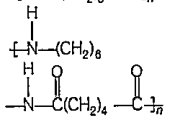In the following reaction,nHOOC(CH2)4COOH+nH2N(CH2)6NH2553K−−−−−−−→High pressure
The product is




The correct Answer is:B
To solve the problem, we need to analyze the reaction between adipic acid and hexamethylenediamine under high temperature and pressure conditions. This reaction is a classic example of the formation of a polymer through condensation.
1. Identify the Reactants:
- The first reactant is adipic acid, which has the formula HOOC(CH₂)₄COOH. This is a dicarboxylic acid.
- The second reactant is hexamethylenediamine, which has the formula H₂N(CH₂)₆NH₂. This is a diamine.
2. Understand the Reaction Conditions:
- The reaction occurs at a temperature of 553 K and under high pressure. These conditions favor the reaction and help drive the formation of the polymer.
3. Determine the Type of Reaction:
- This is a condensation reaction where two molecules react to form a larger molecule (polymer) while eliminating water (H₂O) as a byproduct.
4. Write the Reaction:
- The reaction can be represented as:
nHOOC(CH2)4COOH+nH2N(CH2)6NH2→Polymer+nH2O
5. Identify the Product:
- The product formed from this reaction is nylon-6,6. This polymer is formed by the alternating units of hexamethylenediamine and adipic acid.
6. Draw the Structure of the Polymer:
- The repeating unit of nylon-6,6 can be represented as:
−NH(CH2)6NHCO(CH2)4CO−
- This shows the amide linkages formed by the condensation of the carboxylic acid and amine groups.
Final Answer:
The product of the reaction is nylon-6,6.
---
- The first reactant is adipic acid, which has the formula HOOC(CH₂)₄COOH. This is a dicarboxylic acid.
- The second reactant is hexamethylenediamine, which has the formula H₂N(CH₂)₆NH₂. This is a diamine.
- The reaction occurs at a temperature of 553 K and under high pressure. These conditions favor the reaction and help drive the formation of the polymer.
- This is a condensation reaction where two molecules react to form a larger molecule (polymer) while eliminating water (H₂O) as a byproduct.
- The reaction can be represented as:
nHOOC(CH2)4COOH+nH2N(CH2)6NH2→Polymer+nH2O
- The product formed from this reaction is nylon-6,6. This polymer is formed by the alternating units of hexamethylenediamine and adipic acid.
- The repeating unit of nylon-6,6 can be represented as:
−NH(CH2)6NHCO(CH2)4CO−
- This shows the amide linkages formed by the condensation of the carboxylic acid and amine groups.
The product of the reaction is nylon-6,6.
Similar Questions
Knowledge Check
- Question 1 - Select One
Consider the following reaction,
CH3CHO+CH2(COOH)2Pyridine−−−−→ΔA
A isACH3COOHBCH3CH2COOHCCH3CH=CHCOOHDHOOC−CH=CH−COOH - Question 2 - Select One
Product of the following reaction is CH3−CH4−CH2−NO2Zn+NH4Cl−−−−−−−→?
A B
B C
C D
D
- Question 3 - Select One
CH3CH3+CH2N2hv−−−→orΔ
The product of the reaction isA BCH3CH=CH2CCH3CH2CH3D
BCH3CH=CH2CCH3CH2CH3D
In the given reaction CH3−CH2−NH−CH2−CH2−CI(i)CH3I(excess)−−−−−−−−−−→(ii)AgOH/Δ[X] is the major product, [X] will be:
View SolutionThe end product (B) of the following sequence of reactions
(CH3CH2)NH+CS2→AHgCI2−−−→ΔB is .View SolutionConsider the following sequence of reactions
CH3COOHSOCI2−−−→ANH2OH−−−−→BHCI−−→C The end product 'C' is .View SolutionIn the following sequence of reactions,
CH3CH2OHKMnO4−−−−→XSOCl2−−−→NH3YBr2/NaOH−−−−−−→
the end product (Z) isView SolutionIn the reaction ,
CH3CH2CH2NH2NaNO2+dil.HCl−−−−−−−−−→0−5∘CP+N2
The product (P) formed isView Solution

